[Updated 10 November, 2025]
After years of hybrid experiments, companies are finally getting serious about making their spaces work smarter. As a result, the office space management software market has surged to $2.5 billion in 2025 - and it’s growing fast, with a projected 15% annual increase through 2033.
Heading into 2026, more than 60% of companies are reimagining the role of the office itself. The focus is shifting toward spaces that adapt - powered by software capable of coordinating bookings, visitors, and day-to-day collaboration in one connected ecosystem.
In this guide, we’ll look at the 10 best office space management software solutions shaping the future of hybrid work. We’ll also dig into their key features, differences, and best-fit use cases to help you find the right one for your workplace.
TL;DR:
- Space management software is a digital tool that helps organizations efficiently plan, organize, and utilize physical workspaces, especially in a hybrid work environment.
- Key features include room and desk booking systems, interactive maps, and robust analytics for occupancy and utilization.
- The software delivers significant ROI by optimizing office layouts, reducing real estate and energy costs, improving productivity, and fostering a better employee experience.
- Successful implementation requires evaluating specific needs, ensuring integration with existing systems, prioritizing a user-friendly interface, and providing adequate training.
- Future trends include integration of AI, IoT, and mobile-first solutions.
Click any software name to read its description:
1. YAROOMS
2. Eden
3. OfficeSpace
4. Envoy
5. Robin
6. Skedda
7. Joan
8. Tactic
9. Eptura
10. Deskbird
What is Office Space Management Software?
Office space management software is a digital system designed to help organizations plan, organize, and optimize how they use their physical workplaces. It acts as a central command center for all things related to workspace planning, occupancy tracking, and resource coordination.
In simple terms, it’s the space management tool that shows who’s using what, where, and when -whether that’s desks, meeting rooms, or shared facilities. Instead of relying on spreadsheets or guesswork, companies use space management software to visualize floor plans, monitor occupancy in real time, and make data-driven decisions about office layout, capacity, and costs.

The Evolution of Space Management in Modern Workplaces
Space management has come a long way from spreadsheets and static floor plans. What used to be a manual, time-consuming process has evolved into a data-driven discipline powered by advanced workspace management software and automation.
From Spreadsheets to Smart Systems
In the past, facility managers tracked occupancy and desk assignments manually: updating charts, measuring floor areas, and juggling move requests. This worked when offices were static, but as organizations grew and hybrid work emerged, manual space planning quickly became inefficient and error-prone.
The Digital Shift
Modern space management systems changed that completely. What started as simple occupancy tracking has evolved into a comprehensive workspace management platform, combining real-time data, interactive maps, desk booking, and analytics.
Today’s office space management software offers full visibility into how space is used across buildings, helping teams make faster, smarter layout decisions.
The Hybrid Era
The rise of flexible and hybrid work models pushed this transformation even further. Workplaces now need to support employees who split time between home and office.
This led to the rise of hot desking, meeting room management systems, and occupancy sensors - core features in today’s best space management tools. They ensure every square meter is used efficiently while keeping the employee experience smooth and predictable.
The Future: Intelligent and Predictive Workplaces
The next evolution is already here. With AI and machine learning, space management apps are becoming predictive - anticipating occupancy trends, suggesting layout adjustments, and automating resource allocation.
These technologies are turning offices into adaptive ecosystems that continuously optimize themselves based on real-time usage and employee behavior.
In short, space management has evolved from a static administrative task into a strategic business function - one that blends technology, data, and design to create smarter, more human-centered workplaces.
Benefits of Space Management Software
Space management software helps organizations make smarter use of their office space - improving efficiency, supporting hybrid work, and reducing costs. Let’s look at the key benefits in simple terms.
Optimize Office Layouts for Better Use
Space management tools give you a real-time view of how your office is actually used. By analyzing occupancy data, you can see which areas are overcrowded, which sit empty, and where people naturally collaborate.
This helps facility teams redesign layouts, move departments closer together, and create more functional work zones. For example, if analytics show two teams frequently meet but sit on different floors, the space plan can be adjusted to bring them together - saving time and encouraging teamwork.
Support Hybrid Work Models
Hybrid work made flexibility essential - and space management systems make it possible. Employees can reserve desks or meeting rooms in advance through a space management app, while managers can see real-time occupancy to balance on-site attendance.
This prevents double bookings, ensures fairness, and keeps the office running smoothly, no matter how many people come in each day.
Reduce Real Estate and Operating Costs
With accurate utilization data, companies can spot underused areas and make data-driven real estate decisions. That might mean consolidating floors, subleasing space, or converting unused rooms into collaboration zones.
For instance, a space optimization software report might reveal that a third of meeting rooms sit empty most of the week. Instead of expanding, the company can simply reconfigure the existing layout to support more productive use — saving thousands in rent and maintenance costs.
Improve Employee Experience
A well-managed office makes the workday easier. With seat management software or desk space management tools, employees can quickly find and reserve the spaces or equipment they need.
Transparent booking, easy navigation, and clear communication about available space make employees feel supported and more in control of their work environment.
Enable Data-Driven Decision Making
Modern workspace management tools go beyond booking and planning. They collect valuable data on occupancy trends, employee preferences, and usage patterns - insights that help organizations continuously improve.
For example, if data shows that certain collaboration spaces are always full while others stay empty, facility managers can redesign layouts or redistribute resources accordingly. Over time, this leads to smarter investment and a more adaptive workplace.

What Are the Features of a Good Workspace Management Software?
Choosing the right office space management software starts with understanding which features actually make a difference in daily operations. Below are the essential capabilities every space management system should include to help you plan smarter, improve space utilization, and support hybrid work.
Room and Desk Booking
A room and desk booking system is the foundation of effective space management. It allows employees to easily reserve meeting rooms, desks, or shared areas from a single platform.
Look for a space management app that includes:
-
Real-time availability updates
-
Calendar integrations (Outlook, Google, Teams)
-
Mobile booking options
-
Custom booking rules and approval workflows
This setup eliminates double bookings and ensures everyone has access to the spaces they need - when they need them.
Interactive Maps and Wayfinding
Interactive maps and wayfinding features make navigating large or multi-floor workplaces effortless. With workspace management tools that provide real-time floor plans, employees and visitors can instantly locate desks, meeting rooms, or teammates.
The best space management systems include:
-
Searchable, interactive floor maps
-
Wayfinding routes showing the fastest path to rooms or people
-
Color-coded zones by department or function
-
Mobile-friendly navigation for on-the-go use
These features not only make the office easier to navigate but also save time and reduce interruptions, especially for new employees or guests unfamiliar with the layout.
.png?width=680&height=440&name=desk%20booking%20with%20yarooms(1).png)
Example: desk booking using an interactive office floor map
User-Friendly Interface
A tool only works if people actually use it. Look for office space planning software with a clean, intuitive interface and features like:
-
Drag-and-drop floor planning
-
Custom dashboards
-
Responsive mobile design
A simple, well-designed platform improves adoption, reduces training time, and encourages employees to manage bookings independently.
Reporting and Analytics
Data is what turns space management software into a strategic tool. Reporting dashboards show how space is actually being used - revealing trends, bottlenecks, and opportunities to optimize layouts.
Key insights include:
-
Occupancy rates and space utilization trends
-
Cost per square foot or resource
-
Predictive analytics for future needs
For example, YAROOMS workspace management software helps facility managers identify underused spaces, track hybrid attendance, and plan layout adjustments based on data, not guesswork.
.png?width=800&height=533&name=Yarooms%20utilization%20analytics%20complete@0.33x%20(1).png)
Example: space utilization analytics
Security and Compliance
Data privacy and access control are critical in any facility space management software. The best tools include:
-
Role-based access permissions
-
Data encryption
-
GDPR or HIPAA compliance
-
Regular system audits
These measures keep sensitive workplace and employee data secure while maintaining compliance standards.
Integration with Existing Systems
Your space management platform should connect easily with other business systems. This ensures smooth data flow and eliminates manual updates.
Top integrations include:
-
HR and facility management systems
-
Building access or automation tools
-
Calendar and communication apps (Microsoft 365, Google Workspace, Slack)
-
Single Sign-On (SSO) for secure, centralized user access across platforms
This interoperability keeps everything in sync — from desk bookings to headcount data — across your entire workspace management system.
 Example: YAROOMS space management software integrated with Microsoft Outlook
Example: YAROOMS space management software integrated with Microsoft Outlook
Scalability
As your company grows, your space management tools should scale with it. Prioritize systems that offer:
-
Multi-location support
-
Flexible user licenses
Scalable workspace management software ensures your investment remains future-proof, adapting easily to new teams, office expansions, or hybrid work shifts.
How to Choose the Best Space Management Tools for Your Office?
Choosing the right office space management software can completely change how efficiently your workplace runs. The goal is to find a solution that matches your current setup, integrates with your tools, and scales as your organization grows. Here’s what to consider before making a decision.
Evaluate Your Space Needs
Start by identifying your biggest space challenges.
Are meeting rooms always booked while other areas sit empty? Do employees struggle to find available desks? Are you trying to balance hybrid schedules across multiple offices?
A quick space audit - tracking occupancy, booking patterns, and pain points - will show where inefficiencies occur and what features matter most in a space management program.
For example:
-
If your main challenge is coordinating hybrid work, prioritize software with desk booking, seat management, and space utilization analytics. These features make it easy to match attendance with available space and prevent overcrowding or unused desks.
-
If you operate across multiple offices or campuses, choose a tool that provides centralized visibility and reporting. This helps facility managers oversee all locations from a single dashboard and make consistent, data-driven space decisions.
By matching the tool’s strengths to your actual needs, you avoid overpaying for unnecessary features and ensure your workspace management system directly supports how your teams work day to day.
Check Integration Capabilities
The best space management software doesn’t work in isolation - it fits into your existing workflow. When your booking system, communication tools, and access control all talk to each other, workplace coordination becomes effortless.
For example:
-
Calendar integrations ensure that when someone books a meeting room through Outlook or Google Workspace, it’s instantly reflected in the booking system - no duplicate entries or forgotten updates.
-
HR system connections keep user data up to date automatically as teams grow or restructure, eliminating the need for manual admin.
-
SSO (Single Sign-On) simplifies security by letting employees use existing company credentials instead of juggling new logins.
Together, these integrations reduce manual work, improve data accuracy, and ensure your workspace management system runs smoothly behind the scenes — no extra steps or tool-switching required.
Look For Customization and Flexibility
Every workplace is different, and your space management app should adapt to that. Customization ensures your processes - not the software - drive how space is managed.
Look for systems that let you:
-
Adjust booking rules by role or department (e.g., executives can reserve certain areas).
-
Create approval workflows for sensitive spaces or equipment.
-
Configure reports to show data most relevant to your KPIs, like cost per square meter or meeting room occupancy.
-
Apply company branding or naming conventions to help employees feel familiar with the platform.
The more flexible your tool, the longer it stays relevant as your office layout, headcount, and work model evolve.
Prioritize User Experience and Accessibility
Even the smartest workspace management software won’t help if people find it confusing. User experience should be a deal-breaker because adoption drives ROI.
What to look for:
-
Simple, mobile-friendly booking in two or three taps.
-
Searchable, interactive office maps for easy navigation.
-
Clear dashboards showing occupancy and upcoming reservations.
-
Accessible design that works equally well on desktop, tablet, or phone.
The goal is to make booking a room or checking occupancy as natural as sending a message on Teams - so people actually use it.
Research Reviews and References
Your workplace needs will evolve so your office space management system should evolve too.
Choose a vendor that:
-
Supports multiple buildings, time zones, or languages.
-
Offers responsive support and detailed documentation.
-
Regularly updates features and security standards.
Scalable software ensures your investment continues to deliver value, whether your company doubles in size, shifts to hybrid work, or expands internationally.
Evaluate Pricing and ROI
Pricing structures vary widely - from per-user to per-resource or flat subscription models - so it’s essential to understand what you’re paying for and what you’ll gain in return.
When comparing costs, factor in:
-
Included features: analytics, integrations, visitor management, or service bookings may be add-ons.
-
Deployment scale: how many locations, users, or resources you’ll manage.
-
Expected ROI: estimate savings from reduced unused space, fewer scheduling conflicts, or lower real estate costs.
Some vendors, like YAROOMS, provide an ROI calculator to project measurable benefits before purchase, helping you justify investment with data, not guesswork.
How Office Space Management Software Delivers ROI
Space management software isn’t just for organizing floor plans - it’s a proven way to save money, use space smarter, and boost productivity. When used effectively, it delivers measurable return on investment (ROI) across real estate, energy, and workforce performance.
Optimizing Space Utilization
Most offices operate at just 40% capacity, meaning a large portion of space - and rent - is going to waste. With office space utilization software, companies can analyze occupancy data and uncover exactly where inefficiencies exist.
By identifying underused areas - like meeting rooms booked only a few hours a week - organizations can downsize, redesign, or repurpose them to cut unnecessary costs.
For a mid-sized company, improving space utilization by just 20% could free up the equivalent of an entire floor, saving hundreds of thousands in rent, maintenance, and utilities each year.
| Room utilization | Number of rooms needed | Annual cost of rooms | Potential savings |
|---|---|---|---|
| 40% | 100 | $1,570,800 | $0 |
| 50% | 80 | $1,256,640 | $314,360 |
| 60% | 66 | $1,036,728 | $534,072 |
| 70% | 57 | $895,356 | $675,444 |
| 75% | 53 | $832,524 | $738,276 |
| 80% | 50 | $785,400 | $785,400 |
| 90% | 44 | $691,152 | $879,648 |
Example ROI projection using space management software to optimize meeting room usage.
Boosting Energy Efficiency
Smart space management systems also contribute to sustainability goals. By aligning occupancy data with HVAC, lighting, and building automation, companies can automatically adjust energy usage based on real demand.
For example, unused areas can have lights dimmed or temperatures adjusted automatically, reducing utility costs without compromising comfort. Over time, these micro-savings add up to significant annual reductions in energy spend.
Increasing Productivity and Employee Satisfaction
ROI isn’t just financial - it’s also human. Efficient office layouts and easy-to-use booking systems reduce time wasted searching for spaces or equipment. Employees gain autonomy to plan their day better, which improves satisfaction and retention.
Even a 5% improvement in employee productivity from fewer interruptions or better work environments can translate into major business value over a year.
ROI Beyond Cost Savings
The return from space optimization software goes beyond immediate savings. It compounds over time:
-
Lower real estate and energy costs
-
Higher employee productivity and engagement
-
More strategic use of physical assets
-
Better decision-making supported by reliable data
In short, space management tools turn the workplace into a measurable business advantage. What starts as a way to organize resources often becomes a cornerstone of long-term cost efficiency, sustainability, and growth.
10 Best Office Space Management Systems to Consider in 2026
Managing office space efficiently has become a top priority for modern organizations - from hybrid teams coordinating shared desks to enterprises optimizing real estate costs. To help you find the right fit, we’ve researched and compared the best office space management software systems available today.
Our analysis is based on a thorough review of vendor websites, customer feedback on platforms like G2, Capterra, and Software Advice, as well as user discussions across professional forums and social networks.
This comparison reflects data gathered in November 2025 and will be regularly updated to keep pace with evolving features and pricing. For the most accurate and up-to-date details, please refer directly to each vendor’s official page.
| Software | Pros | Cons | Best For / Industries | Company Size | Scalability |
|---|---|---|---|---|---|
| YAROOMS | All-in-one platform (desk, room, hybrid, analytics, visitor mgmt); seamless Microsoft 365 integrations; AI-powered recommendations | Advanced settings require setup time | Finance, tech, education, healthcare, government | Mid-sized to large | ⭐⭐⭐⭐⭐ Enterprise-grade scalability, multi-location ready |
| Eden | Practical, affordable, and simple; supports hourly booking; works with Slack, Teams, and web | Some mobile sync and notification issues | Tech, consulting, finance | Mid-sized to enterprise | ⭐⭐⭐⭐ Scales across departments easily |
| OfficeSpace | AI-powered analytics; excellent for enterprise planning and move management; smooth onboarding | Limited reporting in lower tiers; pricing not transparent | Tech, legal, energy, manufacturing | Large enterprises | ⭐⭐⭐⭐⭐ Highly scalable for global enterprises |
| Envoy | Best for visitor-heavy offices; integrates access control & compliance; intuitive UI | Complex setup for advanced features; some integrations need support | Logistics, healthcare, finance, corporate HQs | Mid-sized to large | ⭐⭐⭐⭐ Strong, with compliance flexibility |
| Robin | AI-driven booking & insights; employee feedback tools; intuitive maps | Setup and floor plan editing take time; learning curve for admins | Tech, professional services, enterprise teams | Mid-sized to enterprise | ⭐⭐⭐⭐ Scalable hybrid work management |
| Skedda | Great policy control and customization; integrates with Microsoft Teams & SSO | Limited analytics depth; interface less modern | Professional services, universities, multi-department orgs | Small to enterprise |
⭐⭐⭐ Flexible scaling, but limited enterprise analytics |
| Joan | Sleek digital signage; simple booking; strong aesthetic appeal | Limited analytics; minor hardware/Wi-Fi issues | Creative industries, education, professional services | Small to mid-sized | ⭐⭐ Scales with device expansion |
| Tactic | Simple hybrid coordination; easy setup; solid analytics for occupancy | UI could be smoother; minor sync bugs | Tech startups, non-profits, small orgs | Small to mid-sized | ⭐⭐⭐ Scalable for SMBs, not enterprise-focused |
| Eptura | Comprehensive enterprise suite; integrates facility, asset, and space management; highly customizable | Limited mobile experience; complex API integrations | Enterprise, education, healthcare, government, energy | Large enterprise | ⭐⭐⭐⭐⭐ Enterprise-level scalability |
| Deskbird | Clean, no-fuss UX; strong EU data compliance; quick adoption | Light analytics, limited customization | EU-based companies, finance, healthcare, public sector | Small to enterprise | ⭐⭐⭐⭐ Modular scalability, data-compliant growth |
Comparing the best office space management solutions
1. YAROOMS: The Most Complete Office Space Management Software
YAROOMS is the complete office space management platform designed to simplify how organizations plan, book, and optimize their workplaces. It unifies desk and room booking, hybrid scheduling, digital signage, and space utilization analytics into one seamless platform.
YAROOMS workspace booking system: click on the media for a self-guided demo
Key Features
-
Flexible space planning: Supports both assigned seating and flexible setups like hot desking and desk hoteling.
-
Smart search: Employees can find desks or rooms with the right equipment and amenities in seconds.
-
Custom booking rules: Managers control who can reserve which spaces and set approval workflows.
-
AI assistant: YARVIS AI suggests ideal desks or rooms based on preferences and team proximity.
-
Interactive maps: Real-time floor plans and digital signage show availability across the office.
-
Seamless integrations: Works with Microsoft Teams, Outlook, and Google Workspace for in-context booking.
-
Automated check-ins: Via QR code, Wi-Fi, or geofencing — freeing unused desks automatically.
-
Analytics dashboard: Tracks occupancy, no-shows, and usage trends for data-driven space planning.
Best For
Mid-sized to large organizations with hybrid teams or multi-location offices, especially those using Microsoft 365. Trusted across finance, tech, education, healthcare, and government sectors.
Pricing
Plans start from $99/month, with advanced analytics, service booking, and multi-location management available on Enterprise plans (€899/month).
Customer Feedback
Positive: Users praise its clean interface and ease of use, saying it “makes daily planning simple and transparent.”
Negative: Some mention that exploring advanced settings takes time, but once configured, the platform is reliable and scalable.
👉 Bottom line: YAROOMS turns complex office coordination into a streamlined, data-driven experience — helping companies make every square meter count.
2. Eden: Flexible Office Space Management Software for Hybrid Teams
Eden offers an intuitive office space management platform that simplifies desk reservations, hybrid coordination, and workplace visibility. It allows employees to book desks from anywhere and helps managers oversee occupancy, hot desking, and team seating in real time.
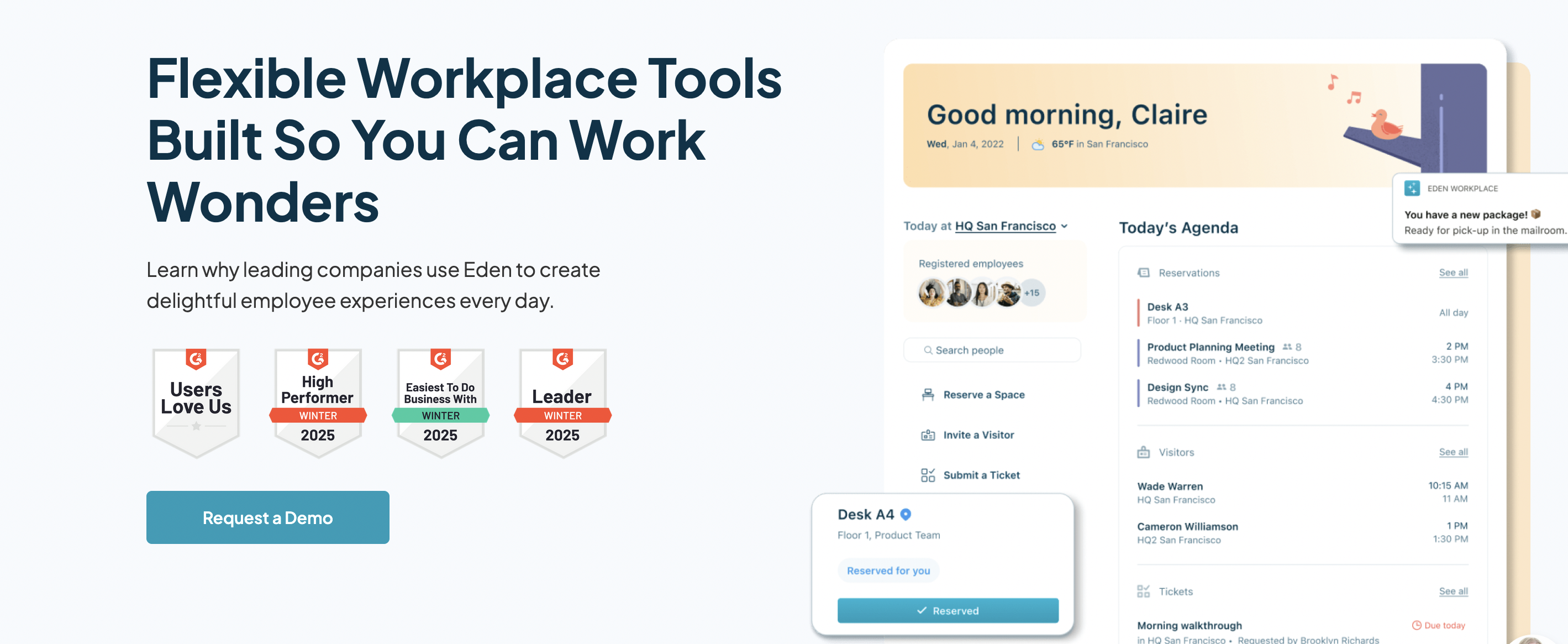
Key Features
-
Interactive floor maps: Employees can browse the office layout and reserve desks directly from a visual floor plan.
-
Multi-platform booking: Book desks through web, Slack, Microsoft Teams, or the Eden mobile app.
-
Hourly reservations: Flexible options let employees book for specific hours instead of full days.
-
Team neighborhoods: Group desks by team or department for better collaboration.
-
Desk filters & amenities: Search for desks with specific equipment or setups.
-
Occupancy metrics: Track usage trends to identify underutilized areas and optimize layouts.
Best For
Mid-sized and enterprise companies - especially in tech, finance, and consulting - looking for a simple workplace management suite. Perfect for hybrid offices that value visibility and easy coordination.
Pricing
Starts at $3 per desk/month, billed monthly (minimum 25 desks). Additional modules, such as room scheduling, visitor management, or ticketing, are available separately.
Customer Feedback
Positive: Users praise Eden’s practicality and affordability, noting it “maintains order and efficiency when moving into a new space” and “does exactly what’s needed without unnecessary complexity.”
Constructive: Some report minor mobile syncing issues and notification overload, mentioning that the interface could be more streamlined for non-technical users.
👉 Bottom line: Eden is a practical, affordable workspace management solution for companies that want flexible space booking, visibility into occupancy, and smooth team coordination.
3. OfficeSpace: AI-Powered Space Management for Large Enterprises
OfficeSpace is an advanced workspace management platform that uses AI to help organizations connect people, spaces, and resources more intelligently. Built for scale, it supports everything from desk and room booking to move management, occupancy tracking, and workplace analytics - making it ideal for enterprise-level real estate and operations teams.
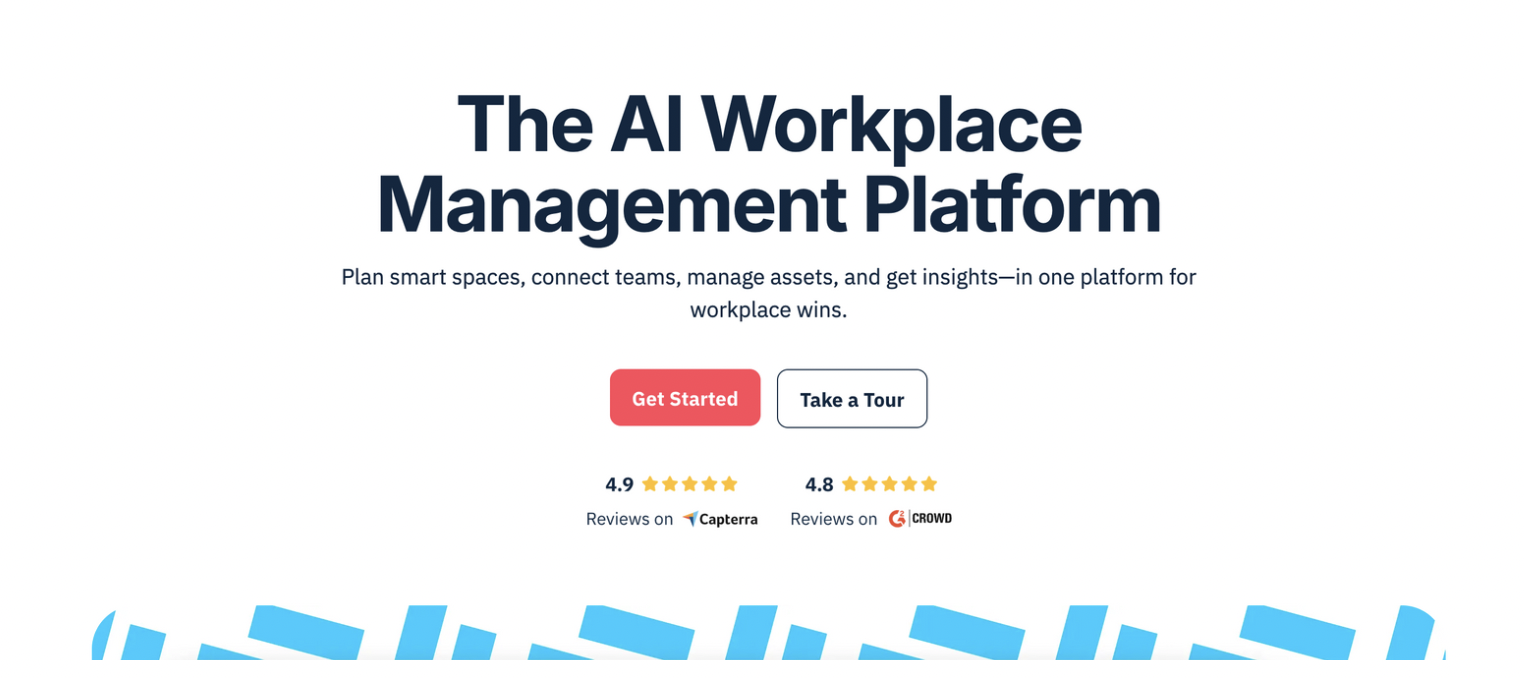
Key Features
-
Smart check-ins: Employees confirm attendance on arrival, giving managers real-time visibility into who’s on-site.
-
Desk & room booking: Reserve spaces via interactive maps, mobile apps, or integrated calendars.
-
AI-driven analytics: Track occupancy, booking trends, and utilization to optimize space planning.
-
Internal communications: Broadcast announcements or policy updates directly through the platform.
Best For
Mid-sized to large enterprises in energy, tech, legal, or manufacturing sectors that need a scalable space management system with advanced analytics, asset tracking, and AI-powered decision support.
Pricing
OfficeSpace follows a tiered subscription model — Lite, Essentials, and Pro — with pricing available on request. Each plan adds progressively advanced features for large-scale workplace operations.
Customer Feedback
Positive: Users praise its intuitive design, smooth onboarding, and strong customer support. Many highlight its ability to simplify space planning and daily bookings across large office networks.
Negative: Some reviewers mention limited reporting and customization in lower-tier plans, plus occasional bugs after updates. Pricing transparency is also a common request from smaller organizations.
👉 Bottom line: OfficeSpace is a powerful, enterprise-ready office space management solution for organizations that need data-backed insights, AI optimization, and reliable scalability to manage complex workplaces efficiently.
4. Envoy: Space Management Software for Visitor-Heavy Hybrid Workplaces
Envoy is an all-in-one office space management platform that combines desk and room booking, visitor management, delivery tracking, and space analytics in one intuitive system. It’s built for hybrid workplaces where employee coordination, guest experience, and compliance all matter equally.
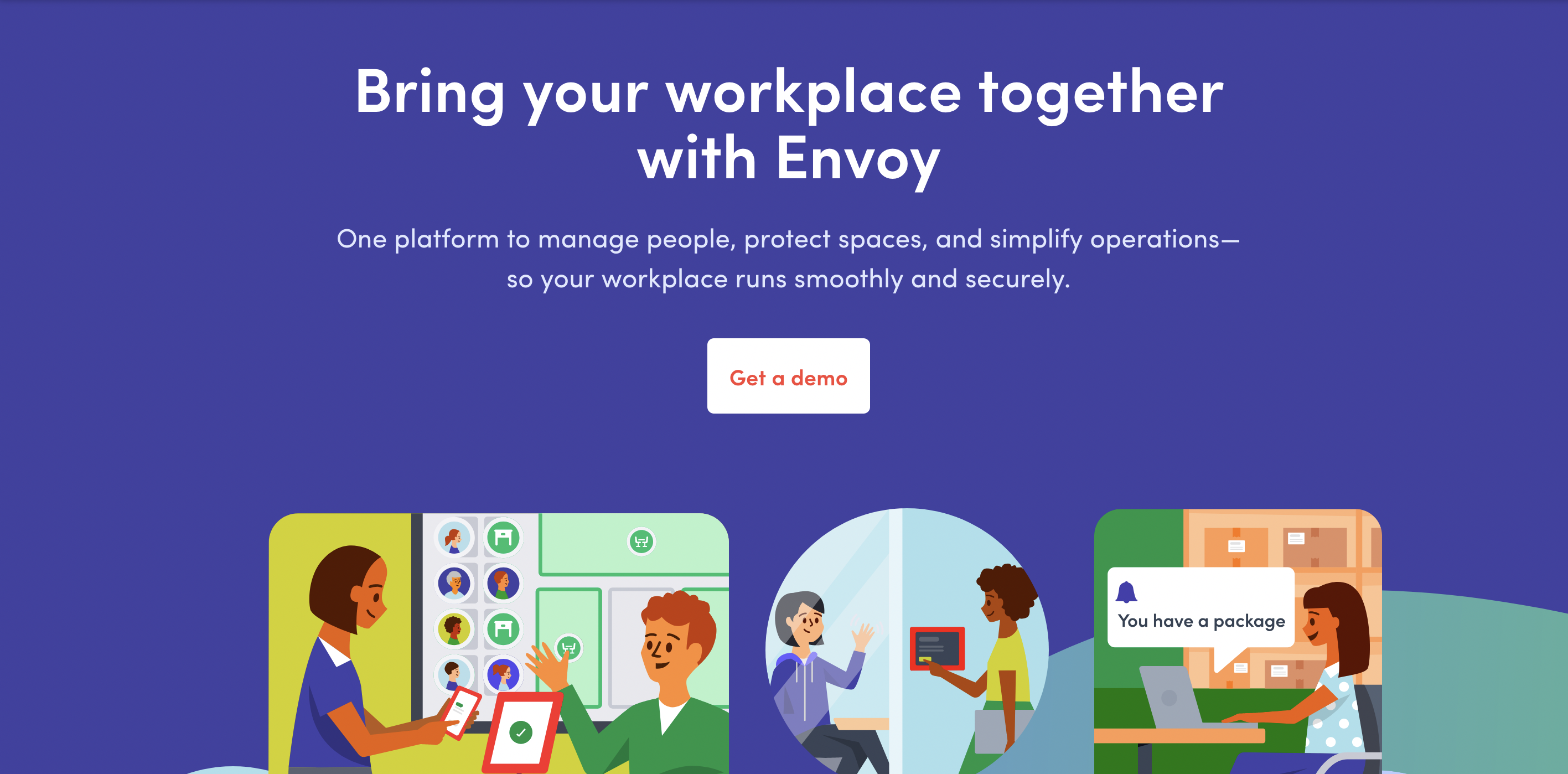
Key Features
-
Desk & room scheduling: Reserve spaces via mobile or web, using interactive floor plans, auto check-in, and smart reminders.
-
Visitor & delivery management: Streamlined sign-ins with QR codes, badge printing, host notifications, and real-time delivery alerts.
-
Analytics dashboard: Reports on occupancy trends, room usage, and forecasting to improve layouts and cost efficiency.
-
Integrations & compliance: Works with Outlook, Google Calendar, Slack, Teams, and access control systems, supporting SSO and industry compliance standards.
Best For
Organizations that manage frequent visitors, deliveries, or high-security operations, such as corporate offices, logistics hubs, healthcare providers, and financial institutions.
Pricing
Envoy offers tiered pricing (Standard ~$3, Premium ~$5, Premium Plus ~$7 per user/month, billed annually). Higher tiers include deeper analytics, priority support, and expanded integrations.
Customer Feedback
Positive: Users praise Envoy’s smooth visitor check-ins, intuitive design, and seamless booking experience for employees and guests alike. Minimal training is needed to get started.
Negative: Some mention that setup can be complex and advanced integrations (like printers or access control systems) may need additional support. Higher-tier features are not always available on basic plans.
👉 Bottom line: Envoy is the go-to workspace management system for organizations balancing hybrid work coordination with high visitor traffic.
5. Robin: AI-Driven Space Management System for Hybrid Workplaces
Robin is an AI-driven workplace management platform built to help organizations make smarter use of their office spaces. It unifies desk and room booking, hybrid scheduling, visitor management, and workspace analytics—giving companies a clear, data-informed view of how their offices are used day to day.
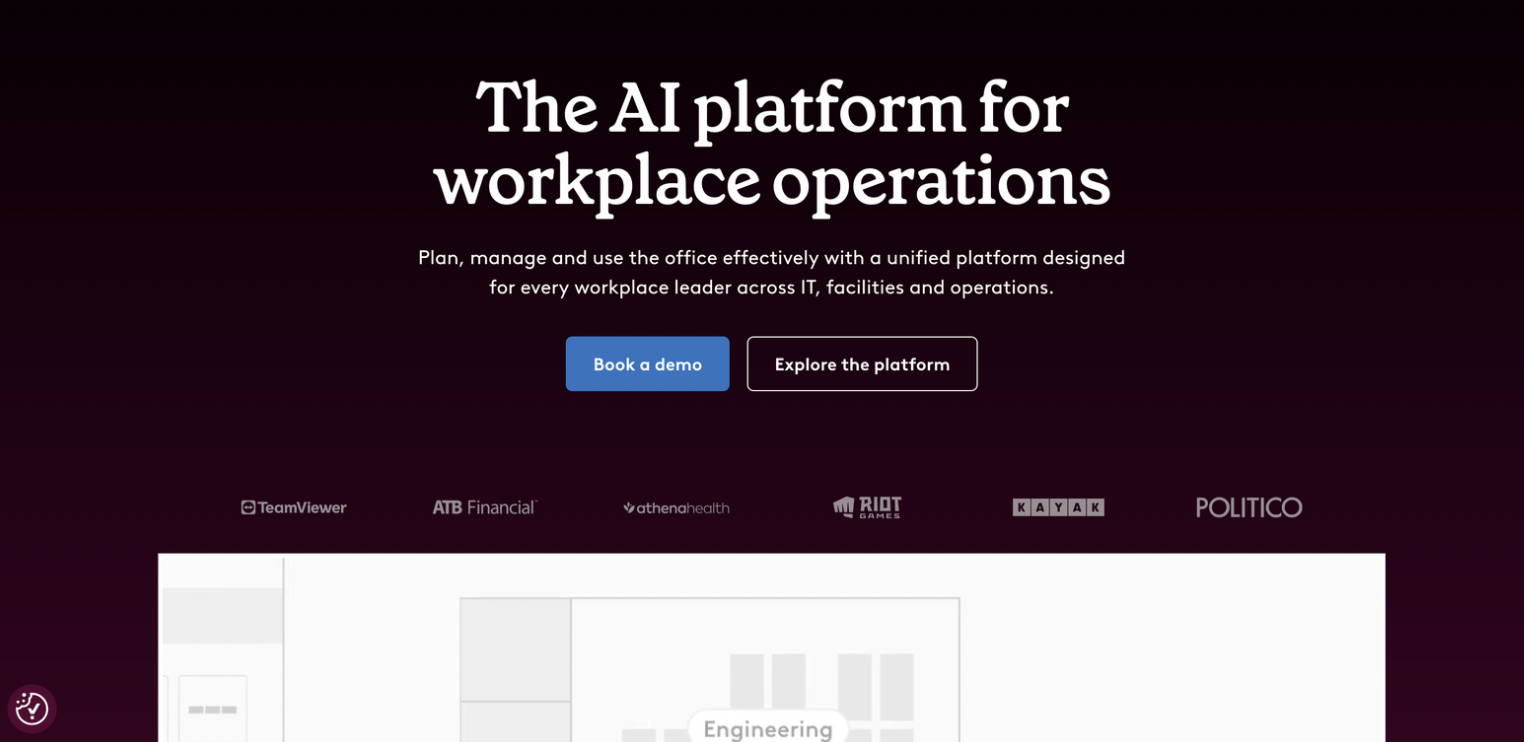
Key Features
-
AI-powered booking: Intelligent recommendations help employees find the best desk or meeting room based on team proximity, preferences, and availability.
-
Seat assignments: Configure fixed desks, team zones, or neighborhood layouts for flexible or structured seating.
-
Wayfinding tools: Interactive maps and digital signage make it easy to navigate the office and locate people or spaces.
-
Employee experience surveys: Gather and analyze feedback on workspace satisfaction to continuously improve the office experience.
Best For
Mid-sized to enterprise organizations in technology, professional services, or corporate environments that want to leverage AI for smarter office space management.
Pricing
Robin uses a custom quote-based model, with pricing dependent on organization size, feature needs, and support requirements. While this allows flexibility, it can make upfront cost comparisons more challenging.
Customer Feedback
Positive: Reviewers highlight Robin’s user-friendly interface, strong calendar integrations (Google, Outlook), and smooth room and desk booking process. Many appreciate its AI suggestions that simplify hybrid scheduling.
Negative: Some users mention check-in workflows feel clunky, occasional booking glitches, and time-consuming floor plan edits. Admins also note that training is needed to fully utilize all advanced features.
👉 Bottom line: Robin stands out among workspace management tools for its AI-powered automation and data insights, helping companies transform hybrid work from reactive coordination to proactive, intelligent space management.
6. Skedda: Best for Policy-Driven Space Management
Skedda is a space management platform designed for organizations that need a balance between user simplicity and admin control. It helps employees reserve desks and meeting spaces effortlessly while giving administrators advanced configuration tools to manage access, policies, and utilization across hybrid workplaces.
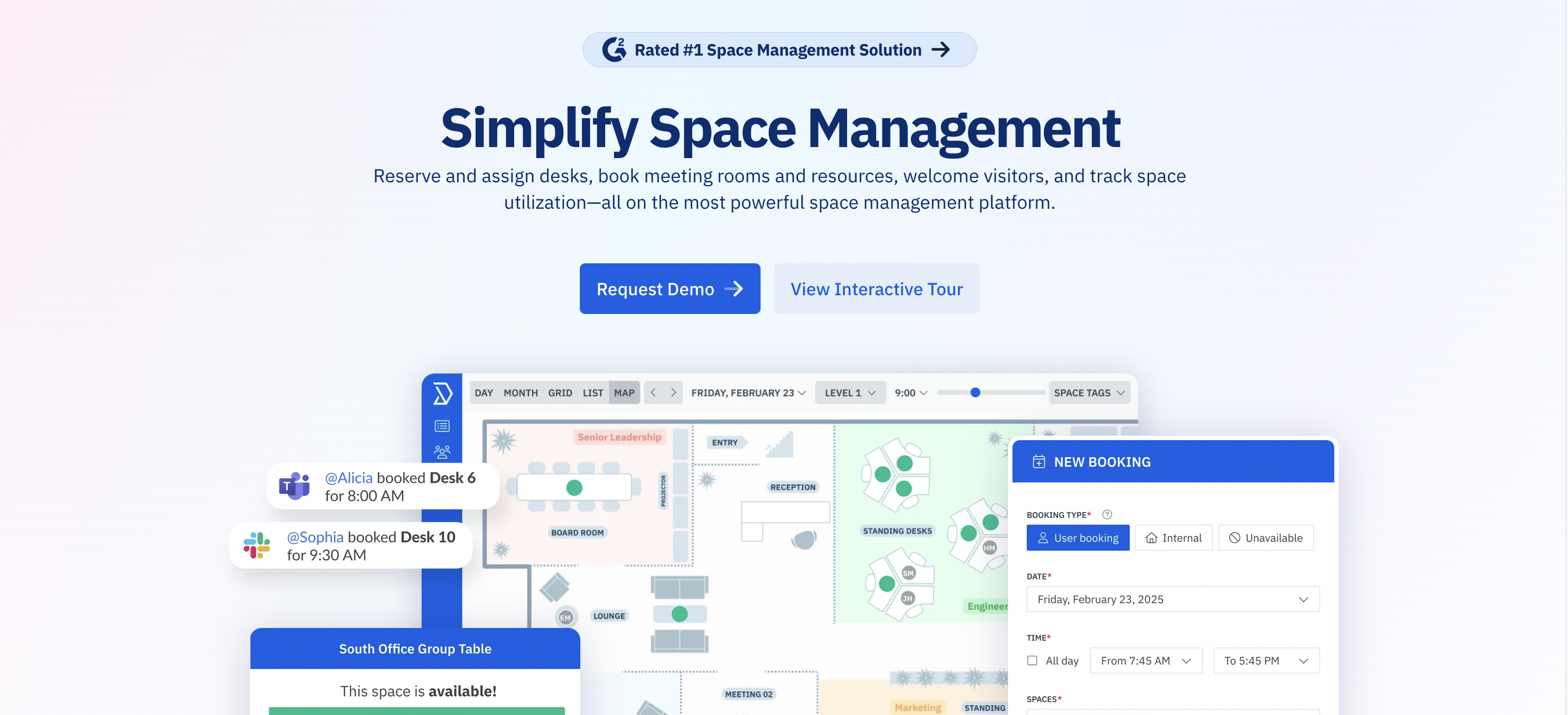
Key Features
-
Office neighborhoods: Group desks by team, department, or function so employees can book near colleagues.
-
Time buffers & booking windows: Prevent overlaps and control how far in advance reservations can be made.
-
Utilization tracking: Monitor booking trends, no-shows, and peak usage to guide layout and policy decisions.
-
Automated check-ins: Free up unused desks automatically if users don’t confirm attendance.
-
Integrations: Connect seamlessly with Microsoft Teams, Google Workspace, Slack, and SSO systems for easy adoption.
Best For
Perfect for multi-department organizations such as professional services firms, universities, and enterprises that need tight policy enforcement, flexible booking logic, and clear visibility into how workspaces are used.
Pricing
Skedda offers flat-rate monthly plans based on the number of managed spaces:
-
Starting at $99/month, scaling by the number of desks or rooms.
-
All plans include unlimited users and bookings, plus a free 30-day trial.
-
Higher tiers unlock advanced reporting, custom booking rules, and admin-level controls.
Customer Feedback
Positive: Users value Skedda’s interactive floor plans, Microsoft and Teams integrations, and granular customization (like access rules, colors, and space tagging). Admins praise the ability to tailor booking policies to complex multi-office environments.
Negative: Some users cite limited reporting depth and integration challenges. Others describe the interface as less intuitive than newer workspace management tools.
👉 Bottom line: Skedda is ideal for organizations that need precision control and transparent booking policies—offering robust customization and structure while keeping the booking process straightforward for employees.
7. Joan: Space Management Software With Smart Digital Signage
Joan Workplace is a sleek office space management system that combines room and desk booking, visitor management, and digital signage to create a smarter, more connected workspace.
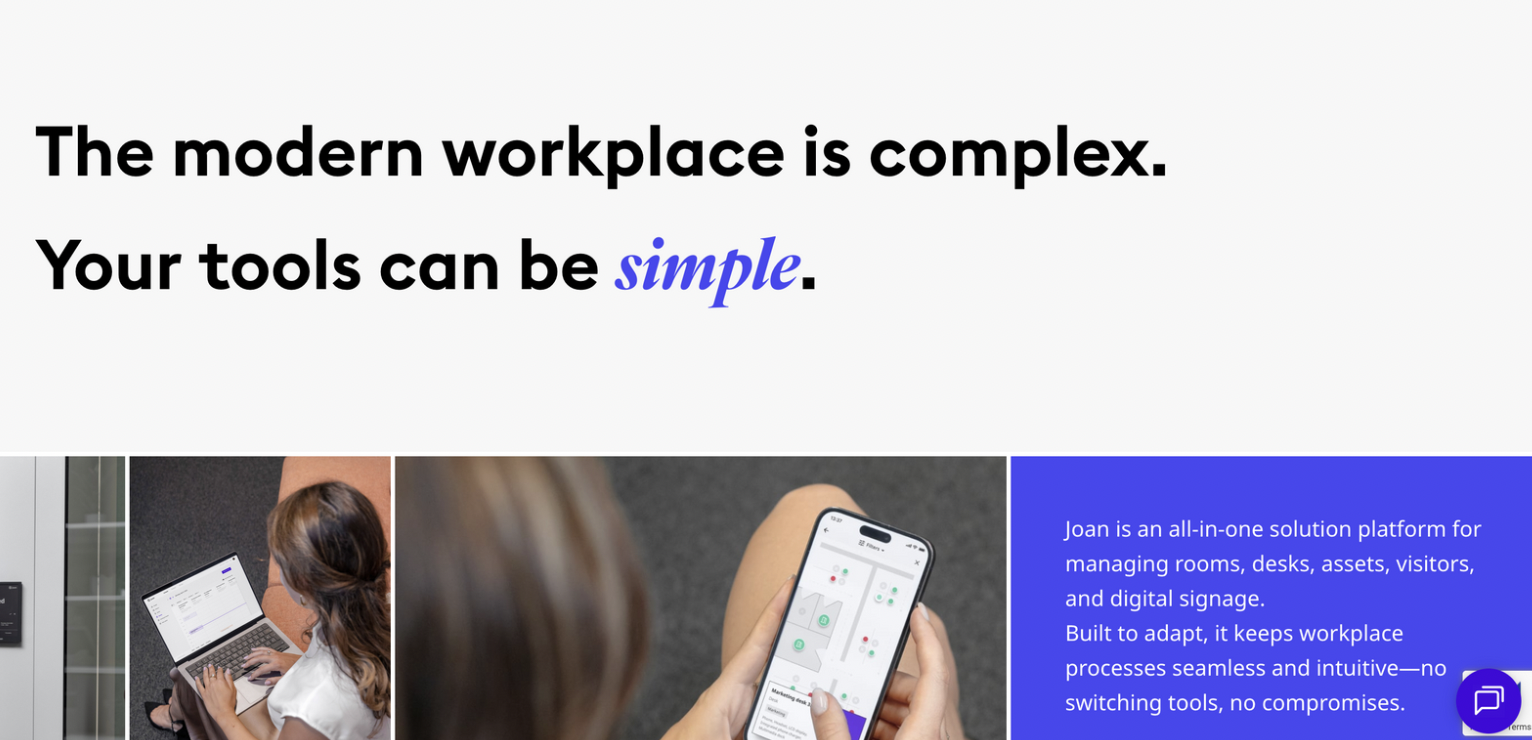
Key Features
-
Space & asset booking: Reserve desks, meeting rooms, and shared equipment from one platform.
-
Digital signage: Display live room availability, announcements, and wayfinding on Joan’s energy-efficient e-Paper or LCD devices.
-
Analytics dashboard: Track space utilization and occupancy trends to inform layout and planning decisions.
-
Mobile app: Manage bookings, schedules, and space availability on the go.
Best For
Ideal for professional services, education, design studios, and corporate offices that value aesthetics and efficiency. Suitable for both small to mid-sized teams and enterprises seeking a modern, low-maintenance way to manage spaces across multiple locations.
Pricing
Joan plans start around €59/month for small teams and scale up to €1,249/month for larger organizations. A 30-day free trial is available for new users.
Customer Feedback
Positive: Users praise Joan for its elegant hardware, intuitive interface, and seamless calendar integrations. The e-Paper displays are particularly valued for their simplicity and energy efficiency.
Negative: Some users mention sluggish touch response, short battery life, and occasional Wi-Fi connectivity issues. A few note that limited analytics and engagement tools make it better suited for straightforward office coordination than for complex hybrid workplaces.
👉 Bottom line: Joan stands out among workspace management systems for its beautifully designed digital signage and intuitive space booking tools, making it a top choice for organizations that want their workplace technology to look as good as it performs.
8. Tactic: Space Management Software for Hybrid Coordination
Tactic is a workspace management software built to simplify hybrid work coordination across desks, rooms, and teams. It combines flexible booking tools, occupancy analytics, and team visibility features, helping organizations reduce wasted space, plan collaboration days effectively, and keep the office running smoothly without manual oversight.
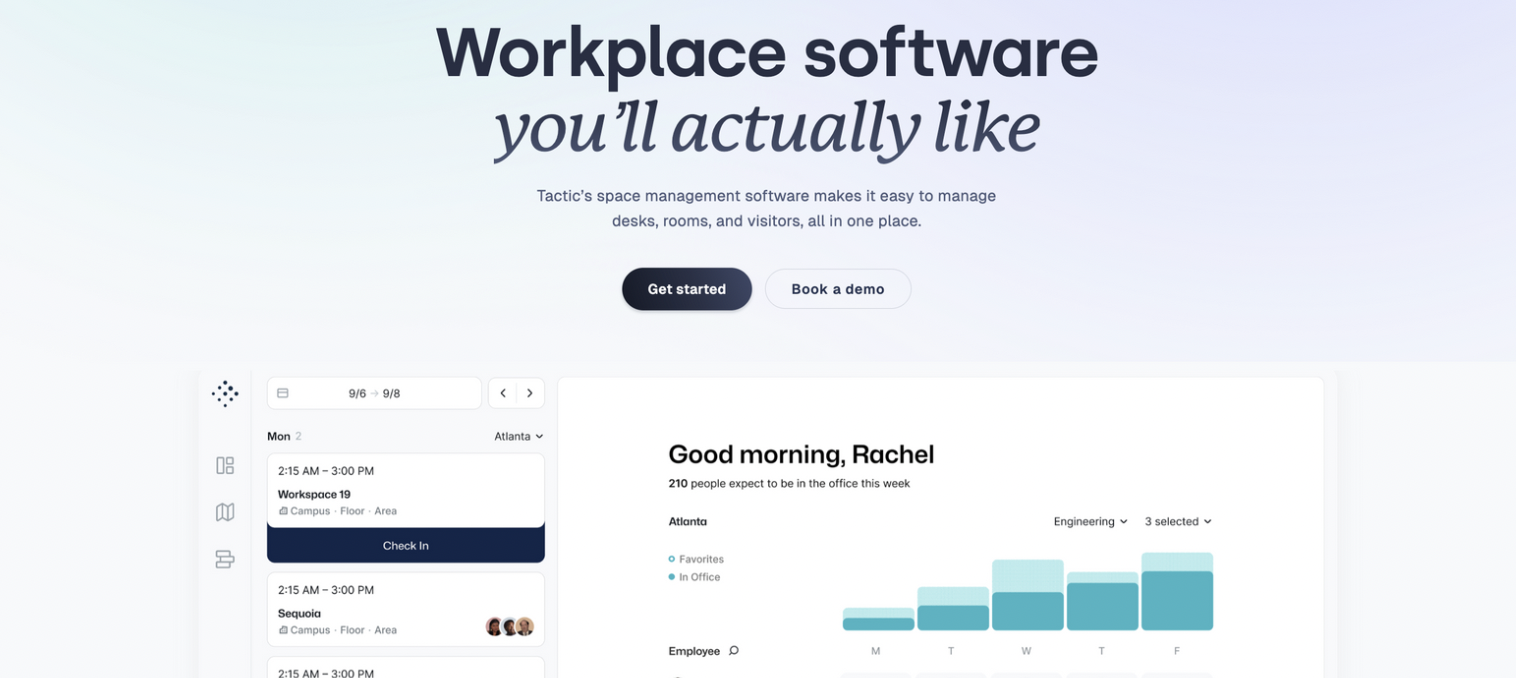
Key Features
-
Smart booking: Reserve desks, meeting rooms, and shared resources with options for recurring reservations, check-ins, and reminders.
-
Office insights: Track occupancy and usage trends to understand how spaces are used and where to optimize layouts.
-
Team coordination: Give employees visibility into who’s working where and when, making it easier to plan collaboration days.
-
Visitor pre-registration: Simplify guest coordination with advance registration and host notifications.
Best For
Perfect for small to mid-sized hybrid organizations that want to balance flexibility and structure without complex enterprise systems. Tactic works especially well for tech companies, startups, and co-located teams looking to unify bookings, scheduling, and occupancy insights in one simple platform.
Pricing
Tactic's rates are not publicly listed.
Customer Feedback
Positive: Users appreciate Tactic’s clean design, easy setup, and strong calendar integrations, calling it “simple but powerful” for managing daily office logistics. The occupancy data and team visibility features are particularly valued for improving collaboration and planning.
Negative: Some users mention minor sync issues with recurring bookings and note that the UI for long-term reservations could be smoother.
👉 Bottom line: Tactic is great for hybrid teams that want effortless booking, real-time occupancy visibility, and smoother in-office coordination.
9. Eptura: Enterprise-Grade Space and Facility Management Software
Eptura is an enterprise workplace and facility management suite designed to help large organizations optimize real estate portfolios, streamline maintenance, and improve the employee experience.
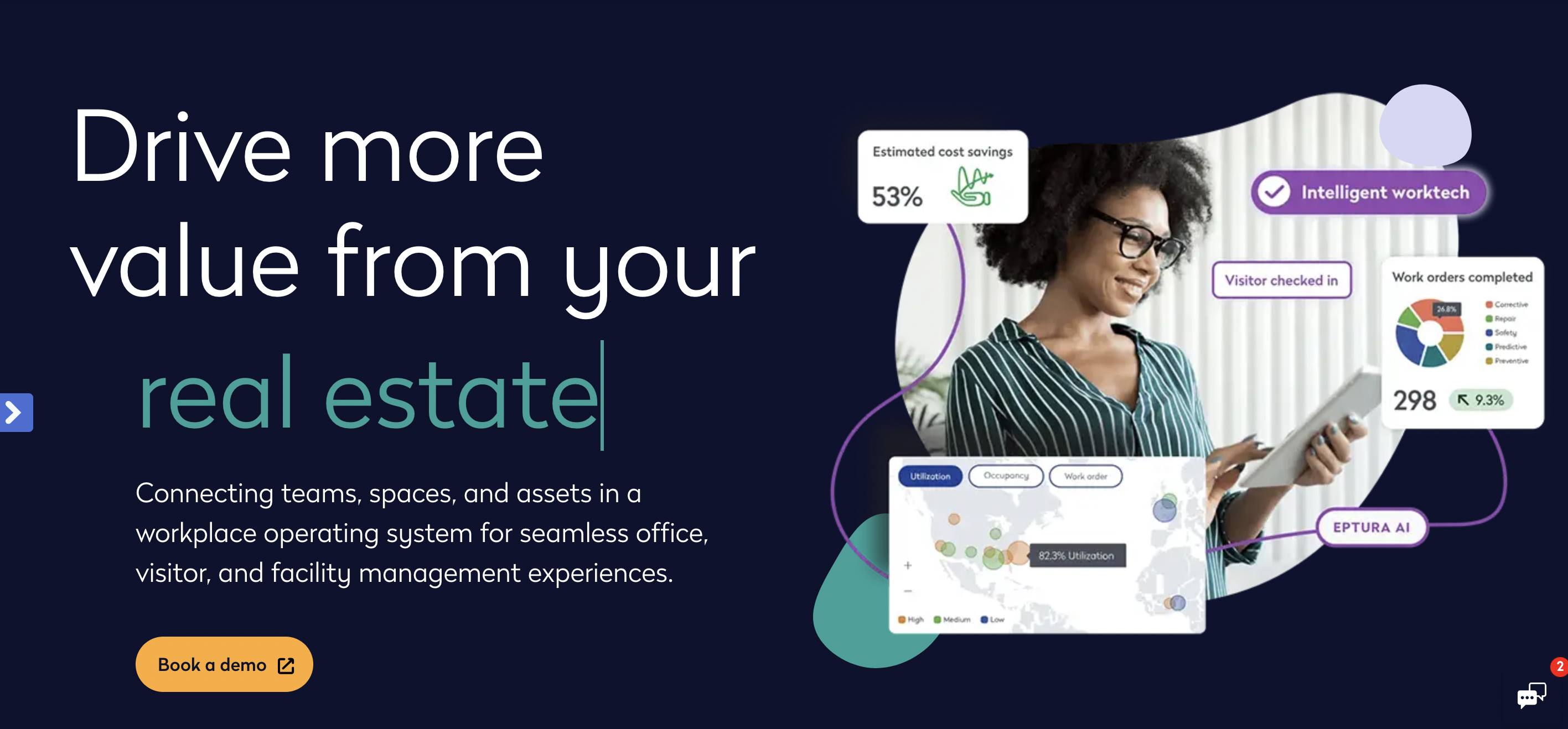
Key Features
-
Asset management: Track and manage all workplace assets on digital floor plans, including maintenance schedules and lifecycle data to reduce downtime.
-
Facility management: Centralize vendor coordination, maintenance, and building operations for faster, smarter facility oversight.
-
Space reservations: Allow employees to reserve desks, meeting rooms, parking, or storage areas through interactive maps.
-
Space planning: Use real-time occupancy and move data to optimize layouts; integrates with Autodesk for precision floor plan visualization.
Best For
Eptura is a good choice for large enterprises and multi-site organizations in sectors such as education, energy, government, healthcare, transportation, and professional services.
Pricing
Eptura offers quote-based pricing depending on selected features and deployment scale. Pricing is not publicly listed and typically requires a custom proposal aligned with organizational needs.
Customer Feedback
Positive: Users praise Eptura’s flexibility, enterprise scalability, and intuitive implementation. The platform adapts to both structured corporate processes and dynamic workplace needs, with strong support during onboarding.
Negative: Some reviewers mention limited mobile functionality, complex API integrations, and a desire for faster support response times.
👉 Bottom line: Eptura is a powerful all-in-one workplace and facility management solution that excels in complex, enterprise environments.
10. Deskbird: No-Fuss Space Management Software
Deskbird is a Swiss office space management platform designed with a focus on simplicity, flexibility, and strict EU data privacy standards. It unifies desk and room booking, hybrid week planning, visitor management, and integrations.
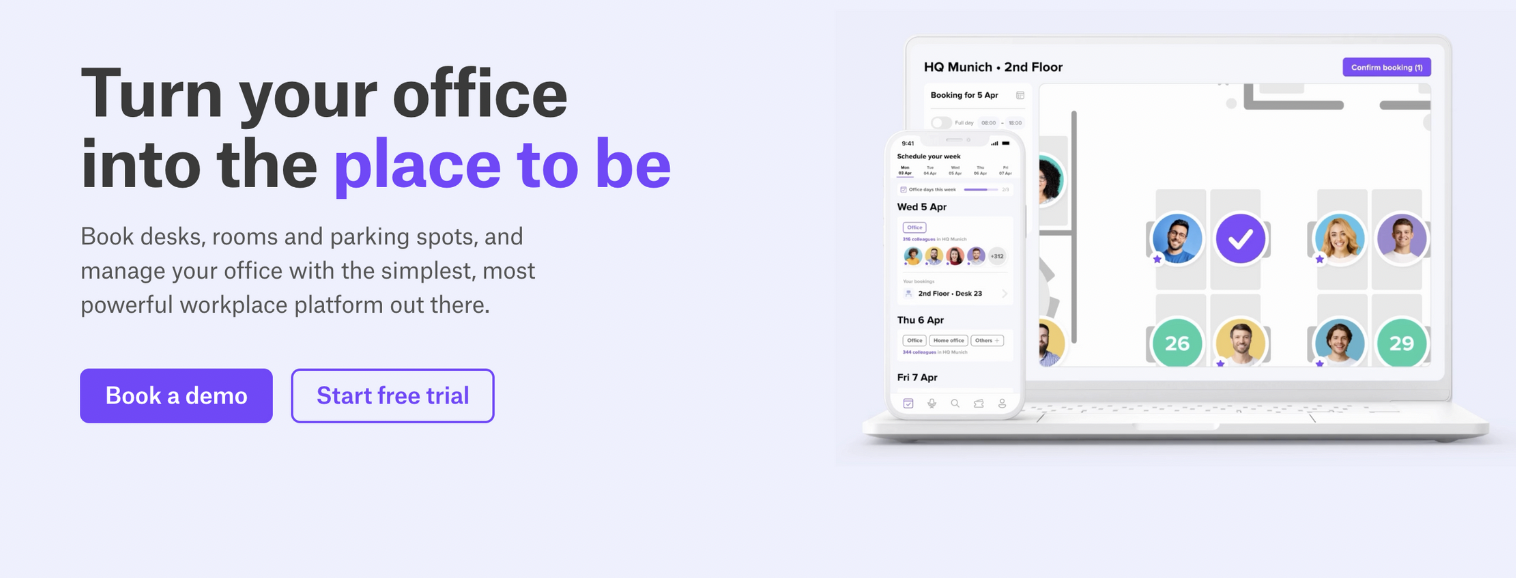
Key Features
-
Desk, room & parking booking: Reserve desks, meeting spaces, and parking spots in seconds.
-
Hybrid week planning: Plan office days in advance, see who else will be in, and coordinate team presence effortlessly.
-
Integrations: Sync with Outlook, Google Calendar, and Microsoft Teams for unified scheduling.
-
Enterprise-grade compliance: Swiss-based hosting with GDPR and ISO 27001 certification, ensuring top-tier EU data protection.
Best For
Perfect for EU-based organizations or data-sensitive sectors (like finance, healthcare, or government) that need workspace management with full compliance and an intuitive user experience.
Pricing
Deskbird follows a modular pricing model, with costs varying by module:
-
Desks: from ~€3.50 per user/month
-
Rooms: from ~€18 per resource/month
-
Visitors: from ~€187 per month
Customer Feedback
Positive: Users praise Deskbird’s clean interface, quick setup, and smooth integrations. The mobile app and easy booking experience make it especially popular for hybrid workplaces.
Negative: Some reviewers mention limited customization for complex workflows, lighter analytics, and occasional sync quirks, such as canceled bookings still appearing or issues during office closures.
👉 Bottom line: Deskbird is a good choice for teams that value ease of use, strong integrations, and top-tier data compliance without sacrificing flexibility.
Implementation Strategies for Space Management Software
Define Clear Goals
Start by setting specific, measurable objectives. What do you want to achieve:
-
Improve space utilization and eliminate wasted capacity?
-
Enhance employee experience through smarter booking and navigation?
-
Reduce real estate and energy costs?
Documenting these goals early will guide every implementation step and make ROI easier to track later.
Form a Cross-Functional Implementation Team
A successful rollout requires input from all sides of the business. Include representatives from:
-
Facilities management, for layout and occupancy insights.
-
IT, to manage integrations and security.
-
HR, to align workspace policies and employee data.
-
Department heads, to ensure usability fits real workflows.
This team ensures your workspace management tools meet both organizational and employee needs.
Collect and Analyze Current Data
Before turning on your new system, audit your current space. Gather:
-
Occupancy and attendance rates
-
Floor plans and department allocations
-
Booking history and pain points
This baseline helps tailor the space management system to your actual usage patterns and gives you a clear “before and after” view of its impact.
Customize and Integrate
Work with your vendor to align the space management platform with your operations. Configure layouts, booking policies, and permissions.
Then, integrate with your existing systems - Microsoft 365, HRIS, access control, or building automation tools - to eliminate double data entry and ensure everything syncs seamlessly.
Pilot Before Full Rollout
Start small. Launch the software in one department or floor first to test workflows and gather feedback. This helps identify integration issues, usability gaps, or policy conflicts before scaling organization-wide.
Use this phase to fine-tune rules for desk booking, seat management, or resource reservations.
Train, Communicate, and Encourage Adoption
Even the best office space management system fails without user buy-in.
-
Run short training sessions or provide quick how-to videos.
-
Communicate why the change is happening—time savings, fewer conflicts, better visibility.
-
Encourage feedback through surveys or dedicated Slack/Teams channels.
When employees understand how the tool benefits them, adoption rates soar.
Monitor, Measure, and Improve
Implementation doesn’t end with launch. Continuously monitor KPIs like:
-
Booking rates and utilization trends
-
Space cost per employee
-
Employee satisfaction or feedback
Regular reviews help optimize your workspace management strategy and uncover opportunities for further improvement, like reconfiguring underused areas or automating more workflows.
Rolling out a space management system isn’t a one-time project - i’s an ongoing process of refinement. With a clear roadmap, strong internal collaboration, and consistent measurement, you’ll not only streamline operations but also create a workspace that truly supports how your teams work best.

Case Studies: Office Space Management Software In Action
Real-world examples show how space management software can transform workplaces, boosting efficiency, visibility, and employee satisfaction. Here’s how three organizations successfully implemented YAROOMS space management software to modernize their workspace operations.
Mercury Insurance: Simplifying Hybrid Desk Management
Challenge: Mercury Insurance, a leading multi-line insurance company with 4,400 employees and 9,400 agents, faced major coordination issues when transitioning to a hybrid work model. Desk reservations were confusing, and teams lacked visibility into who would be in the office.
Solution: Mercury chose YAROOMS, integrated directly within Microsoft Teams, to create a customized workspace management system. The setup included interactive floor plans and hyperlinks connecting internal tools, all accessible in one interface.
Results:
-
Stress-free desk booking for all employees
-
Real-time analytics on occupancy and usage
-
Reduced scheduling errors and manual admin work
-
Safer, more transparent return to the office
Outcome: With YAROOMS, Mercury Insurance built a centralized and fully customized hybrid office system, eliminating guesswork and improving employee experience across locations.
ASEE Romania: Hybrid Work Made Transparent and Efficient
Challenge: ASEE, one of Southeastern Europe’s top IT companies with 3,700 employees across 23 countries, struggled to manage its newly downsized hybrid workspace. Excel sheets made tracking attendance and desk reservations time-consuming and error-prone.
Solution: By adopting YAROOMS integrated with Microsoft Teams, ASEE gained a unified space management program for hot desking, office bookings, and real-time utilization insights.
Results:
-
Automated presence tracking and attendance logging
-
Clear visibility into daily office occupancy
-
Reduced HR and admin workload
-
Annual savings of approximately €200,000 through optimized space use
Outcome: ASEE replaced manual processes with smart office automation, turning its Romanian office into a model of hybrid efficiency and cost optimization.
University of Sydney: Smarter Space Use Without Expanding
Challenge: The University of Sydney’s Faculty of Science was running out of space. Outdated tools offered no visibility into how classrooms and labs were being used, and poor usability frustrated staff.
Solution: After evaluating multiple systems, the Faculty chose YAROOMS for its intuitive interface, flexible hot desking, and data-driven space utilization reports.
Results:
-
Avoided over $100,000 in unnecessary building expansion costs
-
Improved booking experience and system adoption
-
Introduced flexible desk sharing and hybrid scheduling
-
Enhanced employee satisfaction and workplace accessibility
Outcome: According to Paul Brooks, Enterprise Solutions Senior Officer, YAROOMS “improved functionality and created a positive, more flexible work environment.”
Trends and Future Directions in Space Management Software
As workplaces evolve, space management software continues to advance, adapting to new technologies, hybrid work patterns, and employee expectations. Here are the major trends shaping its future.
AI-Powered Space Optimization
Artificial Intelligence and machine learning are redefining how organizations plan and use their office space.
Modern space management systems can now:
-
Predict occupancy trends and peak usage times
-
Recommend optimal layouts based on collaboration patterns
-
Automate desk and room assignments based on employee preferences
These intelligent insights help companies use every square meter more efficiently while improving employee comfort and productivity.
Smart Offices Through IoT Integration
The Internet of Things (IoT) is turning workplaces into responsive environments.
Sensors track occupancy, temperature, lighting, and air quality in real time, feeding data directly into workspace management software.
This enables:
-
Accurate space utilization analytics
-
Automatic energy optimization
-
Healthier, better-balanced indoor environments
IoT integration helps organizations make informed decisions about cleaning schedules, HVAC settings, and overall workspace performance.
Listen to the podcast: How IoT Enhances Efficiency, Cuts Costs & Makes Workplaces More Sustainable
Immersive Planning with VR and AR
Virtual and augmented reality are emerging as powerful space planning tools. They allow facility managers to:
-
Visualize and test office layouts virtually before implementation
-
Conduct 3D walkthroughs for renovation or relocation planning
-
Showcase proposed changes to leadership and employees
This reduces costly trial-and-error and accelerates decision-making.
Mobile-First and Hybrid-Ready Solutions
As hybrid work model becomes the norm, mobile-first space management apps are essential. Employees expect to:
-
Reserve desks or rooms on the go
-
Check real-time availability from their phones
-
Coordinate in-office schedules with teammates
The best systems unify physical and virtual workplaces, ensuring a seamless experience whether employees are on-site or remote.
Human-Centered and Customizable Experiences
As workforces become more diverse, user experience is a growing priority. Expect to see:
-
Personalized dashboards showing relevant spaces and bookings
-
Voice-activated search or booking features
-
Configurable layouts and accessibility options
The goal is clear: make space management tools as intuitive and inclusive as possible.
FAQ: Office Space Management Software
What Is the Difference between Space Management Software and IWMS?
Space management software focuses specifically on how workplaces use their physical space. It helps organizations track occupancy, manage floor plans, plan layouts, and optimize space utilization across offices or coworking environments.
An Integrated Workplace Management System (IWMS), on the other hand, is broader. It combines space management with other facility-related functions such as real estate portfolio tracking, maintenance scheduling, sustainability reporting, and capital project management.
In short:
-
Space management software = best for optimizing how your office or coworking space is used day to day.
-
IWMS = an all-in-one platform for managing every aspect of the workplace lifecycle - from leases and assets to energy and maintenance.
If your main goal is space planning and utilization, space management tools are usually enough. For enterprise-level facility oversight, an IWMS delivers the full picture.
Which Office Space Management Solution Supports Multi-Location Space Planning?
Several office space management systems support multi-location management, but YAROOMS stands out for its ability to centrally plan, monitor, and optimize multiple offices from one platform.
With YAROOMS, workplace and facility teams can:
-
Manage different buildings, floors, or global locations in a single dashboard.
-
Apply consistent booking rules, permissions, and policies across all sites.
-
View real-time occupancy and utilization data per location to compare performance and identify optimization opportunities.
-
Enable employees to book desks, rooms, or resources at any office they visit - perfect for hybrid and distributed teams.
This makes YAROOMS an ideal choice for organizations operating regional or international offices that want unified visibility and control over all their spaces.
Which Workplace Management Solutions Offer Automatic Capacity Limits for Rooms?
Many modern workplace and space management solutions now include automatic capacity management to help organizations maintain safety, comfort, and compliance in shared spaces. Tools like Robin, OfficeSpace, and YAROOMS let administrators set predefined occupancy limits for meeting rooms, desks, or entire office areas — preventing overbooking and ensuring a smooth flow of people throughout the workspace.
YAROOMS, in particular, offers smart capacity controls that automatically restrict bookings once a room or area reaches its defined limit. For example:
-
If a meeting room is set for 8 people, YAROOMS will block additional reservations beyond that number.
-
Facility managers can monitor and adjust limits directly from the admin dashboard, ensuring compliance with company policies or health regulations.
This feature helps maintain a safe and efficient work environment, especially in hybrid or high-traffic offices where flexibility and control are equally important.
How Much Does Office Space Management Software Cost?
The cost of office space management software varies depending on the size of your organization, the number of locations you manage, and the features you need.
Here’s a general breakdown:
-
Small businesses can expect to pay between $2–$8 per user/month for basic space management tools that include desk and room booking.
-
Mid-sized companies typically spend $200–$600 per month for multi-feature platforms with integrations, reporting, and admin controls.
-
Enterprises often choose custom-priced plans (starting around $800–$1,500 per month) to support multiple sites, analytics, and advanced features like service booking, hybrid scheduling, and compliance tools.
Many vendors also provide ROI calculators or free trials so you can estimate savings before committing.
What Are the Three Basic Elements of Space Management?
The three core elements of space management are planning, allocation, and utilization.
-
Space Planning – Determining how office areas, meeting rooms, and shared zones should be arranged to support work styles, collaboration, and growth.
-
Space Allocation – Assigning desks, rooms, or departments to employees and teams based on roles, schedules, and organizational needs.
-
Space Utilization – Monitoring how spaces are actually used through data and analytics to identify underused areas, reduce waste, and improve efficiency.
Together, these three elements help organizations create smarter, more flexible, and cost-effective workplaces that align with both business goals and employee needs.


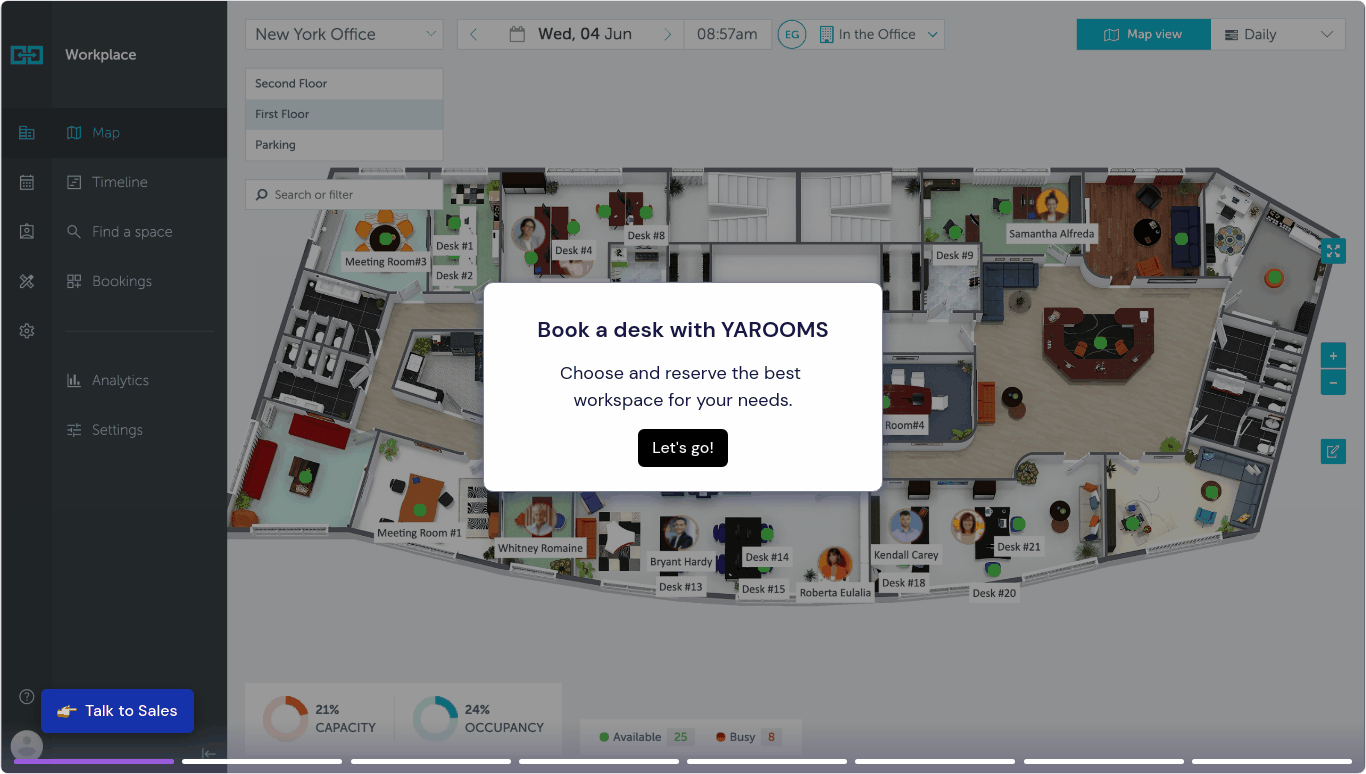
.png)









